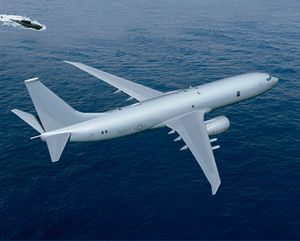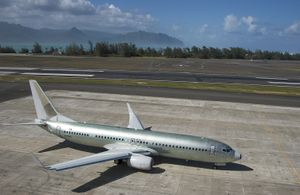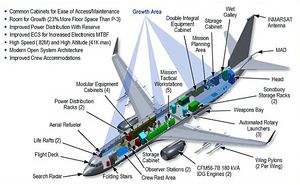PlaneSpottingWorld welcomes all new members! Please gives your ideas at the Terminal.
P-8 Poseidon
| P-8 Poseidon | |
|---|---|
| A rendering of a P-8A, showing the additional antennas and underwing pylons, and aerial refueling guides in detail. | |
| Type | ASW/ASuW |
| Manufacturer | Boeing Integrated Defense Systems |
| Maiden flight | 2009 (Projected) |
| Introduced | 2013 (Projected) |
| Primary user | United States Navy |
| Developed from | Boeing 737 |
The P-8A Poseidon (formerly the Multimission Maritime Aircraft or MMA) is intended to search for and destroy submarines, conduct shipping interdiction, and also possibly engage in an electronic intelligence (ELINT) role. This will involve carrying torpedoes, depth charges, Harpoon anti-shipping missiles, and other weapons. It will also be able to drop and monitor sonobuoys. It is designed to operate in conjunction with the Broad Area Maritime Surveillance unmanned aerial vehicle. The P-8 is to be built by Boeing's Integrated Defense Systems division from the 737-800.
Contents
Overview
The P-8's predecessor, the Lockheed P-3 Orion ASW aircraft has been in service with the U.S. Navy since 1961. In the mid-1980s the Navy began studies for a replacement aircraft for the P-3 which has lost range/time on station capabilities due to increasing weight and is approaching the end of its fatigue life. The Navy specification also required reduced operating and support costs. In 1989 the Navy awarded a fixed-price contract to Lockheed to design and build two prototype aircraft, to be designated the P-7. This project was canceled in 1990 following a $300 million cost overrun by Lockheed and resulting delays.
Boeing and Lockheed Martin were part of a new competition for a replacement aircraft begun in 2000. Lockheed submitted the Orion 21, an updated, but new-build, version of the P-3 turboprop, based upon the Electra airliner, and Boeing submitted a proposal centered around their 737-800ERX airliner. BAE Systems offered a new build version of the Nimrod, the UK's jet powered maritime patrol aircraft since 1969. However, BAE withdrew from the competition in October 2002, recognizing the political reality that the failure to find a US-based production partner made the bid unrealistic.[1]
On June 14, 2004, Boeing won the competition.[2] Initial operating capability is expected to be 2013. The project is expected to be for at least 108 airframes for the U.S. Navy alone, and perhaps more to other nations operating over 200 P-3s. Project value is expected to be worth at least $15 billion, or as much as $45 billion. Raytheon, Northrop Grumman, Smiths Aerospace, Marshall Aerospace, CFMI, and BAE are subcontractors.
The P-8 will be based upon a similar but larger airframe variant of the C-40 Clipper and T-43; it is the first militarized variant of the -800 series 737. The aircraft is designated P-8, which is the next in series from the aborted P-7 project. The P-8 is unique in that it has 767-400ER-style raked wingtips, instead of the blended winglets available on other 737NG variants. It also includes 6 additional body fuel tanks, three in the forward cargo compartment and three in the rear, for extended range. These are manufactured by Marshall Aerospace in Cambridge, UK.
The U.S. Navy placed an order for 5 MMA aircraft on July 8, 2004. The first flight test aircraft is scheduled for delivery in 2009. The first aircraft will be test aircraft, and will be converted to production standards at a later date.
In U.S. service the MMA will be complemented by the Broad Area Maritime Surveillance UAV system, which will provide continuous surveillance. The system is expected to enter service around the end of the decade. Around 40 UAVs will be based at five sites — Hawaii; Diego Garcia; NAS Jacksonville, Florida; NAS Kadena, Japan and Sigonella, Italy. As of 2005, the Global Hawk, the Mariner and Predator UAVs are being considered for the role.[3]
Foreign involvement

Australia is following the MMA project closely, holding observer status. Australia wishes to replace its AP-3C Orion fleet by 2015 and it seems likely that this will be a mixture of a maritime patrol aircraft and UAVs (e.g. Global Hawk). The latter is especially likely, since Australia appears to have budgeted, and potentially paid for, several maritime UAVs.
The Department of Defense wants to follow a program template similar to that of the Joint Strike Fighter program, with international cooperation from prospective MMA users. This would include many of the fifteen nations that currently use the P-3. The MMA project should avoid one of the major problems of the JSF, that of technology transfer. The MMA, while incorporating much high technology, would not include such proprietary and sensitive characteristics as stealth technology. Of all the JSF partners only the UK is enjoying significant technology transfer, and even this is limited.
Italy has been strongly tipped for a purchase of a total of 14 Wedgetail and MMA aircraft, with fleet support provided by Alitalia.[4] Canada, Italy and Australia may each pay up to $300 million in order to have first-tier participation in the MMA project.[5] This may or may not involve workshare agreements. However, with Boeing Australia already participating in the related Wedgetail development, some level of offset seems likely. Boeing has also proposed the P-8A to the Indian Navy (designated P-8I), to replace that service's Il-38 'May' platform.
Signals intelligence
Due to the cancellation of Lockheed Martin's Aerial Common Sensor project, Boeing will propose a signals intelligence variant of the P-8 to service the requirement for the U.S. Army and U.S. Navy.[6]
Specifications
General characteristics
- Crew: Flight:2 Mission:7
- Length: 126 ft 6 in (38.56 m)
- Wingspan: 117 ft 6 in (35.81 m)
- Height: 42 ft 1 in (12.83 m)
- Empty weight: 138,300 lb (62,730 kg)
- Max takeoff weight: 184,700 lb (83,780 kg)
- Powerplant: 2× CFM International CFM56-7B, 27,000 lbf (120 kN) each
Performance
- Maximum speed: 563 mph (906 km/h)
- Service ceiling: 41,000 ft (12,500)
Avionics
Raytheon APY-10 (APS-137 follow-on) surface search radar and SIGINT package
References
- ↑ Lewis, Paul. "BAE pulls out of MMA competition; Lack of US partner prompts Nimrod MRA4 withdrawal", Flight International, Reed Business Information UK, 2002-10-08, p. 5. Retrieved on 2006-12-06.
- ↑ "Boeing Team Wins $3.89 Billion Multi-Mission Maritime Aircraft Program," Boeing press release.
- ↑ Burgess, Richard R. (May 2005). UAV Tests Its Sea Legs: The Global Hawk Has Performed Well On Missions Over Land, But Has Not Been Assigned To Long-Range Surveillance Of The World's Oceans (DOC). Seapower May 2005. Navy Office of Information. Retrieved on December 19, 2006.
- ↑ Aviation Week & Space Technology, June 21, 2004.
- ↑ "U.S. Navy Eyes Three Nations For Possible Role In MMA", Aerospace Daily & Defense Report, November 5, 2004.
- ↑ "Boeing unveils new 737 signals intelligence concept," Flight International, January 26, 2006.
External links
- U.S. Navy official MMA site.
- Boeing official MMA site.
- Navy News announcement
- Globalsecurity.org MMA Page
Related content
Related development
Comparable aircraft
Designation sequence
Related lists
Lists relating to aviation | |
|---|---|
| General | Timeline of aviation · Aircraft · Aircraft manufacturers · Aircraft engines · Aircraft engine manufacturers · Airports · Airlines |
| Military | Air forces · Aircraft weapons · Missiles · Unmanned aerial vehicles (UAVs) · Experimental aircraft |
| Notable incidents and accidents | Military aviation · Airliners · General aviation · Famous aviation-related deaths |
| Records | Flight airspeed record · Flight distance record · Flight altitude record · Flight endurance record · Most produced aircraft |


